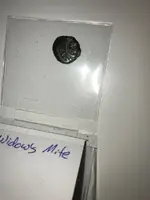FormerTeller
Bronze Member
- #1
Thread Owner
I picked up some Widow’s Mites from the FUN show last month from I believe a reputable dealer in ancient coins. Gave one to my cousin in St. Petersburg, then headed back home to Indiana. Today he texted me the following picture.

If you zoom in, you can see what looks like green verdigris on the coin. Quite sure it wasn’t there 3 weeks ago. My question is what caused it?
I gave it to him in a plastic flip, which I know isn’t ideal for long term storage, but that shouldn’t react with the coin this quickly, should it? Does it have anything to do with being in proximity to the ocean - salt in the air? When I bought the coins they were stored in a sealed plastic bag.
He originally questioned whether the coin was authentic - understandable for a coin this old. Now he’s wondering if the corrosion indicates that the coin is modern. I don’t think so, but am open to outside opinions. Thoughts?
Lastly, what is the best way to conserve the coin? Obviously he would prefer to have a verdigris/corrosion free coin. Best way to “clean” the crud off it?
I’d be appreciative of any comments!

If you zoom in, you can see what looks like green verdigris on the coin. Quite sure it wasn’t there 3 weeks ago. My question is what caused it?
I gave it to him in a plastic flip, which I know isn’t ideal for long term storage, but that shouldn’t react with the coin this quickly, should it? Does it have anything to do with being in proximity to the ocean - salt in the air? When I bought the coins they were stored in a sealed plastic bag.
He originally questioned whether the coin was authentic - understandable for a coin this old. Now he’s wondering if the corrosion indicates that the coin is modern. I don’t think so, but am open to outside opinions. Thoughts?
Lastly, what is the best way to conserve the coin? Obviously he would prefer to have a verdigris/corrosion free coin. Best way to “clean” the crud off it?
I’d be appreciative of any comments!



